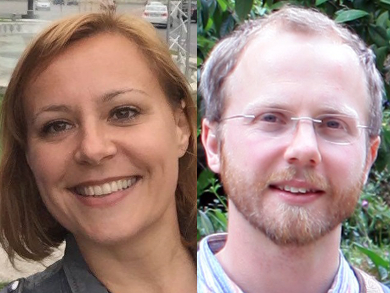Dr. Dave Smith, Editor of ChemSusChem, talks to Professor Maria-Magdalena Titirici and Dr. Joe Briscoe of Queen Mary University of London, UK, about their recent article on carbon nanodot solar cells from renewable precursors. In this work, carbon nanodots synthesized from a wide range of biomaterials including chitin, chitosan, and lobster shells are used as sensitizers for TiO2-based nanostructured solar cells.
Please could you briefly explain the importance of solar cells and why they are subject to such a high degree of current interest?
Solar cells are very important today, as they offer a renewable alternative to traditional fossil-fuel-based energy generation. They can be used to generate electricity directly from sunlight without producing any CO2 emissions. Importantly the cost of commercial solar cells has dropped significantly in recent years so that they are now competitive with fossil fuel and nuclear energy generation in some parts of the world. Hence they are currently receiving a great deal of interest and large commercial growth.
Big advancements have also been made in research-level technologies in the last five years, with efficiencies of many technologies increasing significantly. This is driving growing efforts to develop viable alternatives to current silicon-based technologies to further drive down costs while using sustainable and non-toxic materials.
What is the significance of using carbon nanodots as sensitizers for solar cells, as opposed to the more established light-absorbing dyes?
Many established light-absorbing dyes use rare elements – the most common being ruthenium – and complex chemical synthesis methods. While this produces dyes with high light absorption within the desired range of the solar spectrum, it also makes them very expensive. Also, the use of rare elements limits the scale-up of the technology to mass-production levels.
Carbon nanodots (CNDs) can be derived from waste biomass materials by using a simple hydrothermal process, and as such they are based on renewable materials containing mostly carbon – one of the most abundant elements on earth. They are, therefore, extremely attractive as a sustainable and cheap alternative to current optoelectronic materials.
You tested CNDs from a variety of sources, including polysaccharides, amino acids, and raw lobster shells. What was the thinking behind these choices of starting biomaterials?
We looked into this range of biomaterials with two main aims. One was to investigate materials that can be derived from food waste, such as chitin and chitosan, while we also looked at the actual food waste in the form of lobster shells. To go into more detail, we wanted to understand how the chemical functionality of the CNDs affect the performance of the solar cell. Hence, we also looked at amino acids, as they are a biologically-derived material that combines amine functionality, which we previously found to be beneficial for the solar cells, with carboxylic acid functionality, which is commonly used in traditional dyes for dye-sensitized solar cells (DSSCs). This led us to find that the amino acids did indeed produce the highest efficiencies but, interestingly, the lobster shell-derived CNDs were close behind.
How far are technologies such as this one from widespread application?
This particular technology using CNDs is a long way from widespread application. The synthesis and applications of these materials is a very new field, and understanding of their properties and how we can control them is still being developed.
In particular, for solar cells, all of the CNDs that we produced showed poor light absorption in the main part of the spectrum (the visible), whereas standard dyes for DSSCs absorb very strongly in this region. Hence the efficiency of CND-sensitized solar cells is still below 1 %, whereas DSSCs that use conventional dyes regularly attain efficiencies of 7–10%, and have been reported at as high as 14 %.
What are your plans for future work following on from this study?
The main focus for future work is to overcome the issues discussed in the previous question with light absorption. A much better understanding of the electronic states that contribute to light absorption in these materials is needed in order to try to engineer specific absorption properties. This will be assisted by screening a much wider range of materials as precursors. In addition, ways to couple the CNDs more efficiently to the semiconductor scaffolds used in the solar cell are needed, both physically and electronically. This will help to increase the light absorption and internal efficiency of the devices
Did you eat the lobster and, if so, how was it?
The lobster was very tasty. It was the result of Professor Titirici’s last birthday dinner at the Burger & Lobster restaurant in London. The restaurant staff believed it was for a broth.
The article they talked about
- Carbon-Nanodot Solar Cells from Renewable Precursors,
Adam Marinovic, Lim S. Kiat, Steve Dunn, Maria-Magdalena Titirici, Joe Briscoe,
ChemSusChem 2017.
DOI: 10.1002/cssc.201601741


